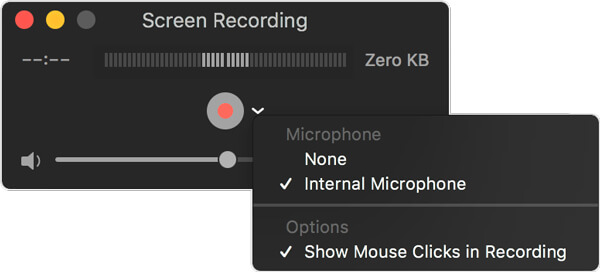- Quicktime Screen Recording With Sound
- Quicktime Screen Recording With Audio
- Soundflower Mac Quicktime Screen Recording
To record your Mac’s Screen with both audio and video:
- Install loopback audio (free extension).
- Open the media you want to screen capture in your application (if it’s a browser, use Firefox or Chrome, not Safari). Start at least 5 seconds before where you want to start – this will usually give time for the application to hide any playback controls which might be distracting. Don’t press play yet.
- Go to System Preferences/Sound. In the sound Output, choose Loopback Audio in the Output tab.
At this point, you will hear no sound from any of your Mac’s applications, but don’t worry. - Go to the QuickTime Player application; choose File/New Screen Recording.
- Choose if you want to record all your screen, or a portion of your screen (highlighted in red below), then click on the Record button.
- Click on the Options menu.
Choose the appropriate audio source, in this case Loopback Audio. - Go to the application that was set to play the video; press play (hopefully you queued up the video to play at least 5 seconds before the area you wanted to capture – this will usually give time for the application to hide any playback controls which might be distracting).
- Mar 14, 2020 Pro tip: How to record your iPhone screen with Quicktime. Quicktime is also a great free screen recorder for other devices, such as your iPhone. Just plug the device into your Mac, select “New Movie Recording” in Quicktime, and choose your device under the recording settings (the arrow next to the red button).
- QuickTime Player is a free, efficient option for users who are after a quick and easy way to record their screen with audio on a Mac. But for serious content creators, QuickTime Player fails to provide certain essential features and options.

After you’re done recording:

- Stop the video in your application that was playing your video.
- At the top of your screen (to the right of Finder menu items), click on the black square, which is the button to stop the Quicktime recording.
Save your video file. - Go to System Preferences/Sound. In the sound Output, change the preference back to Internal Speakers (or whatever was your original choice). You should be able to hear sounds now from your speakers.
- Go to your saved movie in QuickTime Player, and test out the sound. Trim the clip either in QuickTime Player or iMovie.
Quicktime Screen Recording With Sound
QuickTime Player User Guide
How to Record System Audio While Recording Your Screen on Quicktime By Shujaa Imran / Jul 13, 2019 / Mac, Software Hacks The screen recording option in Quicktime is a useful feature for you to record a part of your screen or your entire screen in high quality for whatever purpose. If you are having problems recording your screen using Quicktime on a Mac, then this video may be able to resolve your problem. Click the screen recording op.
Quicktime Screen Recording With Audio
Using Screenshot in the QuickTime Player app, you can make a video recording of your computer screen. You can open the recording in the app and save it on your Mac.
In the QuickTime Player app on your Mac, choose File > New Screen Recording to open Screenshot and display the tools.
You can click Options to control what you record—for example, you can set the location where you want to save your screen recording, or include the pointer or clicks in the screen recording. See Take screenshots or screen recordings.
Click Record. To stop recording, click the Stop Recording button in the menu bar (or use the Touch Bar).
Depending on where you chose to save the recording, an app may open.